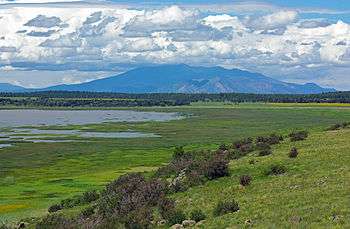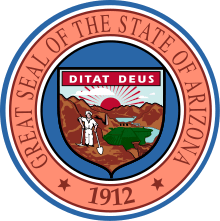Northern Arizona

Northern Arizona is an unofficial, colloquially-defined region of the U.S. state of Arizona. Generally consisting of Coconino County, Yavapai County, Navajo County, and Apache County, it is geographically dominated by the Colorado Plateau, the southern border of which in Arizona is called the Mogollon Rim. Mohave County, located in the northwest of the state, may or may not be considered part of Northern Arizona, depending on local opinions.
Demographics
Flagstaff is the largest city in Northern Arizona. Other cities in the region include Prescott, Sedona, Page, and Williams. Flagstaff is home to Northern Arizona University and the Lowell Observatory.
Much of the territory is National Forest Service land, parkland, reservations, or other BLM-administered lands. In the East are the very large Hopi and Navajo reservations, parts of which overlap, leading to occasional territorial disputes. In this area travelers may tune their radios to hear native-language broadcasts. Native Americans make up the average of 47.87% in Coconino County, Navajo County, and Apache County. Dozens of Anasazi, Sinagua, and other ruins of the ancient Puebloan people can be found throughout the region.
Geography
The region features dozens of mountain ranges, including the state's highest, the San Francisco Peaks. It also contains most of the state's natural lakes. In the West lies the Grand Canyon, which was cut by the flow of the Colorado River while the land slowly rose around it. The elevation ranges from 2200 feet at the bottom of the Grand Canyon to 12,633 feet at Humphrey's Peak. In the central portion lies the Painted Desert, consisting of sedimentary rocks eroded by water and wind, exposing thick, brightly colored layers.
The area is famous for its extremely rugged landscape and variety of environment. Northern Arizona is home to millions of acres of Ponderosa Pine, Aspen, and mixed-conifer forest, including the largest Ponderosa Pine forest in North America. Major attractions in addition to the Grand Canyon include Monument Valley, Canyon de Chelly, the Painted Desert, and Meteor Crater. The major highway is Interstate 40 (roughly following historic route 66) this connects all the major cities of this region. Northern Arizona also goes by the name Alta Arizona, which means "Upper Arizona" in Spanish. Northern Arizona has a large Mormon population, with a temple in Snowflake.
Northern Arizona has many points of interest. The area is well known for its wide variety of outdoor recreation opportunities, abundance of trails and forest service roads, extreme topographical and environmental variability, and its rich geologic and human history. Many of these attractions protect and conserve natural wilderness, ruins of ancient civilizations, and points of other historical or natural interest. The following is a list of some of the more popular natural and man-made attractions that can be found in Northern Arizona.[1]
National Parks and Monuments
The following National Parks and National Monuments are located in Northern Arizona:
- Grand Canyon National Park
- Petrified Forest National Park
- Canyon de Chelly National Monument
- Grand Canyon-Parashant National Monument
- Navajo National Monument
- Sunset Crater Volcano National Monument
- Walnut Canyon National Monument
- Wupatki National Monument
- Vermillion Cliffs National Monument
Natural Attractions
The following is a list of natural attractions that can be found in Northern Arizona.
- Monument Valley
- Painted Desert
- Oak Creek Canyon
- Slide Rock State Park
- San Francisco Peaks
- Red Rock Country
- Lava River Cave
- San Francisco Volcanic Field
- Window Rock
- Antelope Canyon
Other Attractions
The following is a list of points of interest, man made attractions, and other attractions found in northern Arizona.
- Arizona Snowbowl
- Lowell Observatory
- Route 66
- Grand Canyon Railway
- Bearizona
- Museum of Northern Arizona
- Northern Arizona University
- Four Corners Monument
- Jerome, Arizona
See also
References
| Wikivoyage has a travel guide for Northern Arizona. |
Coordinates: 33°33′06″N 112°53′37″W / 33.5517919°N 112.8936787°W
